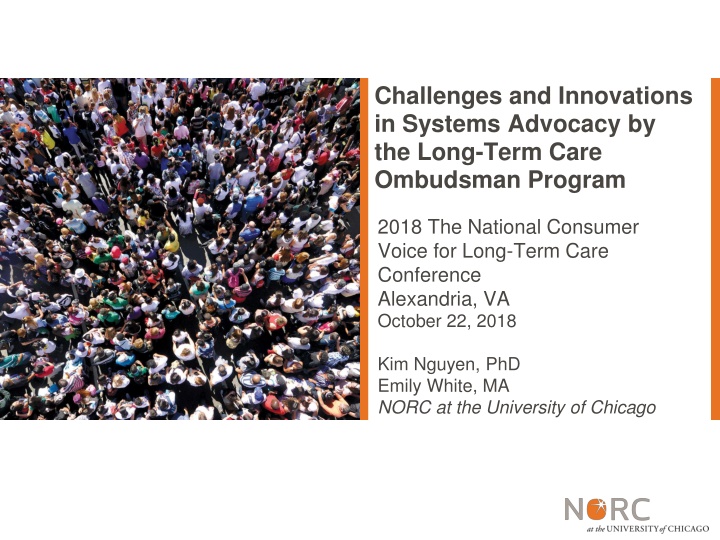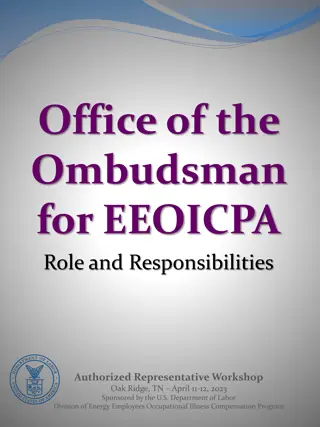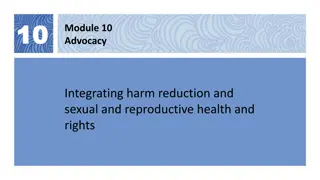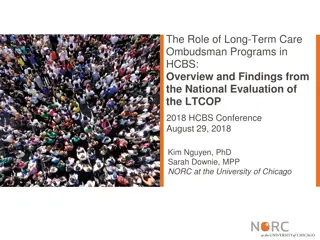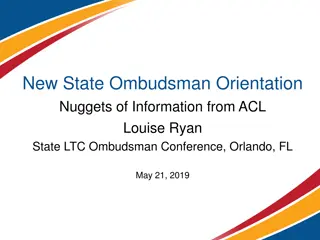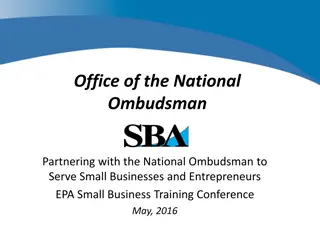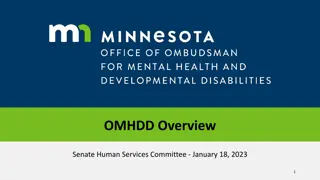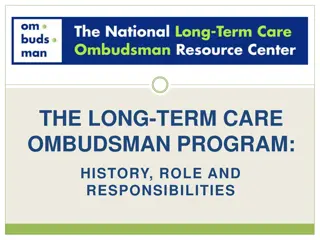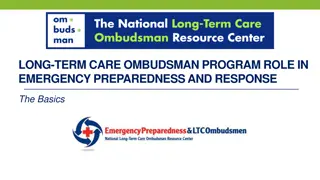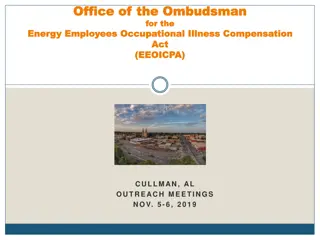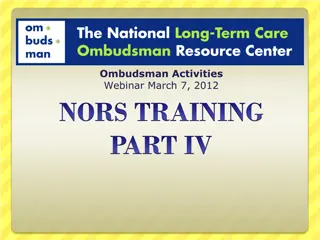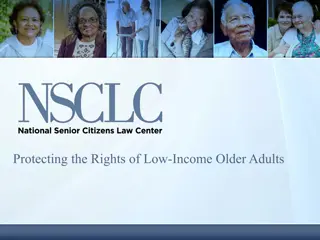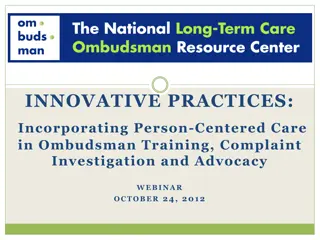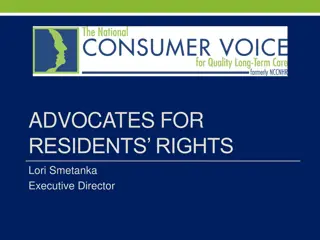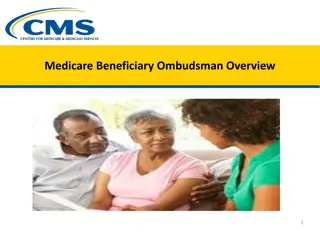Challenges and Innovations in Long-Term Care Ombudsman Program Advocacy
The Long-Term Care Ombudsman Program (LTCOP) plays a crucial role in advocating for residents of long-term care facilities, investigating complaints, and pushing for systemic improvements. Administered state-wise with a significant volunteer workforce, the program collaborates with various entities to enhance residents' quality of life and care. Evaluations by NORC at the University of Chicago and other organizations aim to assess and improve the program's effectiveness through structured research questions.
Download Presentation

Please find below an Image/Link to download the presentation.
The content on the website is provided AS IS for your information and personal use only. It may not be sold, licensed, or shared on other websites without obtaining consent from the author.If you encounter any issues during the download, it is possible that the publisher has removed the file from their server.
You are allowed to download the files provided on this website for personal or commercial use, subject to the condition that they are used lawfully. All files are the property of their respective owners.
The content on the website is provided AS IS for your information and personal use only. It may not be sold, licensed, or shared on other websites without obtaining consent from the author.
E N D
Presentation Transcript
Challenges and Innovations in Systems Advocacy by the Long-Term Care Ombudsman Program 2018 The National Consumer Voice for Long-Term Care Conference Alexandria, VA October 22, 2018 Kim Nguyen, PhD Emily White, MA NORC at the University of Chicago
Overview of LTCOP As authorized by the Older Americans Act (OAA), the Long-Term Care Ombudsman Program (LTCOP) has the following responsibilities nationally: Identify, investigate, and resolve complaints made by or on behalf of residents of long-term care facilities Provide information to residents, families, staff Advocate for systemic changes to improve residents care and quality of life 2
Overview of LTCOP The LTCOP is administered by the Administration on Aging Each state has an Office of the Long-Term Care Ombudsman. 53 programs, including Guam, Puerto Rico, and Washington DC. Each Office is led by a State Long-Term Care Ombudsman. Ombudsmen/Representatives of the Office are advocates for residents of long-term care facilities. 1,320 paid program staff (FTE) in 2016 524 designated local Ombudsman entities in 2016 A large volunteer workforce supports the program to maintain a presence in facilities. 7,331 certified volunteers in 2016 3
Evaluation Team Process Evaluation and Special Studies Related to the LTCOP NORC at the University of Chicago (NORC Chicago) National Consumer Voice for Quality Long-Term Care (Consumer Voice) Brooke Hollister, PhD, University of California, San Francisco Helaine Resnick, PhD, Resnick, Chodorow & Associates William Benson, Health Benefits ABCs Human Services Research Institute (HSRI) 5
Process Evaluation and Special Studies Related to the LTCOP Research Questions How is the LTCOP structured and how does it operate at the local, State, and Federal levels? How do LTCOPs use existing resources to resolve problems of individual residents and to bring about changes at the facility and local, State, and Federal levels that will improve the quality of services available/ provided? With whom do LTCOPs partner, and how do LTCOPs work with partner programs? How does the LTCOP provide feedback on successful practices and areas for improvement? 6
Data Collection Process Evaluation and Special Studies Related to the LTCOP Round 1 Data Collection (2017) Telephone Interviews Federal Staff (5) Stakeholders (19) State Ombudsmen (53) Round 2 Data Collection (2018) Online Surveys State Ombudsmen (52) Local Ombudsmen (497 in 27 states) Volunteers (711 of volunteers in 26 states) 7
Process Evaluation and Special Studies Related to the LTCOP Data Collection Round 2 Local Data Collection (27 States) AoA Region 1 2 3 4 5 IL IN OH MN WI 6 7 IA NE - - - 8 9 10 AK WA - - - ME RI - - - NJ NY - - - DE VA - - - FL KY TN SC - LA NM - - - ND SD - - - AZ CA HI NV - Reporting Findings will be disseminated through a Final Report, research briefs, and conference presentations. 8
What is Systems Advocacy? Advocacy is defined as: The act of pleading for, supporting, or recommending. Systems are defined as: A combination of things or parts forming a complex or unitary whole or a coordinated body of methods or a scheme or plan of procedure. According to the OAA, systems advocacy involves the following: Representing interests of residents Seeking administrative, legal, or other remedies Analyzing, commenting on, and recommending changes to a system to benefit long-term care residents Facilitating public comment on laws, regulations, policies, and actions 10
Who Performs Systems Advocacy? Data: SLTCO Survey, Local Ombudsman Surveys, Volunteer Survey State Ombudsmen 46% report that their statewide program has expertise in systems advocacy. Local Ombudsmen 68% report that the Office of the State LTCO coordinates with local programs to carry out systems advocacy. 88% report that the Office of the State LTCO encourages their local programs to carry out systems advocacy. Volunteers 13% monitor and work on laws, regulations, government policies and actions. 12
Who Performs Systems Advocacy? Data: Local Ombudsman Surveys As part of your responsibilities, do you perform any systems advocacy work? Yes No, systems advocacy is not part of my responsibilities I don t know Local Ombudsmen 57% 26% 17% Among Local Ombudsmen with systems advocacy responsibilities: 30% report that they are unable to perform this task for various reasons (e.g. lack of time, resources, training) 13
Systems Advocacy Paid Staff Data: Local Ombudsman Activities Surveys Which of the following activities do you perform? All Local Ombudsme n N=485**** Yes N=277* No N=121** I don t know N=80*** Advocacy for changes to laws, regulations, or policies 45% 7% 10% 29% Engagement in policy making 20% 5% 2% 13% Grassroots organizing 12% 5% 1% 8% Communication with the media 18% 2% 6% 13% Representing consumers in administrative hearings or appeals processes 35% 42% 21% 34% Involvement in committees such as work groups or task forces 55% 18% 30% 41% Providing information to a public or private agency 45% 52% 31% 38% None of the above 4% 30% 23% 14% *Missing=2; **Missing=4; ***Missing=4; ****Missing=12 14
Systems Advocacy Activities - Volunteers Data: Volunteer Ombudsman Survey Which of the following activities do you perform? Volunteer Ombudsmen N=711 68% Provide information, resources, and support to resident councils Provide information, resources, and support to family councils 28% Monitor/work on laws, regulations, government policies and actions 13% Work with media on issues impacting residents of long-term care facilities 3% Average number of systems advocacy activities performed: Local staff: 2 activities (range = 0-7 out of 7). Volunteers: 1 activity (range = 0-4 out of 4). 15
Coordinating Entities Data: SLTCO Survey, Local Ombudsman Surveys Work together on systems advocacy SLTCO % SLTCO N Local Local Ombudsmen % 51% Ombudsmen N 464 Area Agency on Aging 65% 51 ADRC 31% 51 34% 441 Adult Protective Services 63% 51 38% 453 P&A Systems 52% 50 35% 444 Licensure & Certification 80% 51 50% 455 State Medicaid Fraud Control 43% 51 22% 440 Victim Assistance Programs 25% 51 21% 437 State/Local Law Enforcement 35% 51 28% 447 Courts 20% 50 19% 438 State Legal Assistance 63% 51 31% 444 16
Relationship Benefits and Barriers Data: SLTCO Interviews, Local Ombudsman Surveys Benefits. Relationships are mostly positive and critical to carrying out work. State agencies and other stakeholder organizations assist with: Supporting systems advocacy to improve quality of care for residents Providing the teeth to compel LTC facilities to improve care Education on special populations Barriers. Developing relationships can be challenging due to: Lack of understanding of the LTCOP s role and responsibilities Different perspectives or priorities Time constraints for staff of both LTCOP and coordinating entities 17
Program Resources Data: SLTCO Survey Types of systems advocacy activities not fully carried out due to a lack of resources Resident and family council development and support SLTCO N=52 60% Facilitating public comment on proposed legislation, laws, regulations, policies, and actions Research and policy analysis to inform systems advocacy work 48% 42% Analyzing and monitoring federal, state, and local law, regulations, and other government policies and actions 38% 18
Program Resources Data: SLTCO Interviews, SLTCO Survey, Local Ombudsman Surveys Prioritizing Resources Funding challenges may cause programs to prioritize facility visits and individual case work over systems advocacy Majority of State and Local Ombudsmen agree that funding and staffing are insufficient to meet federal mandates Training Fewer than half of Local Ombudsmen surveyed reported receiving training on systems advocacy in the past year Some State Ombudsmen report a need for additional assistance in training staff to work with legislators 19
Program Structure & Placement Data: SLTCO Survey, Local Ombudsman Surveys Program Structure & Placement State Local Ombudsmen 40% 60% 62% 38% Ombudsmen 26% 74% 73% 27% Centralized Decentralized In SUA Not in SUA My program s organizational structure enables my local program to carry out systems advocacy activities. 75% of Local Ombudsmen in decentralized programs agree, compared to 49% of those in centralized programs. 80% of Local Ombudsmen whose state programs are housed outside of the SUA agree, compared to 66% of those housed in the SUA. 20
Systems Advocacy and Program Autonomy Data: SLTCO Survey Autonomy of statewide program to carry out certain activities Agree / Strongly Agree 17% Disagree / Strongly Disagree 75% N Don t Know Unable to fulfill some program duties due to legislative or regulatory restrictions Autonomy to carry out systems advocacy Free to speak to the media 6% 51 8% 2% 52 90% 15% 12% 4% 6% 52 52 80% 83% Able to represent residents interests to state agencies w/o political interference Majority of SLTCO feel they have autonomy to carry out systems advocacy, although some report a lack of support from their host agency or the state government. Program resources may be the most significant barrier to carrying out systems advocacy. 21
Systems Advocacy Issues Data: Local Ombudsman Surveys, Volunteer Survey Improving facility staffing (ratios, turnover, training) Adequate funding for the LTCOP Proper care for residents with: mental health diagnoses cognitive impairment behavioral/substance use issues Access to LTC for low income individuals, the formerly incarcerated, & registered sex offenders Addressing inappropriate/involuntary discharges/transfers Increasing Personal Needs Allowance (PNA) 22
Kim Nguyen, PhD Emily White 301-634-9495 301-634-9314 nguyen-kim@norc.org white-emily@norc.org Thank you
